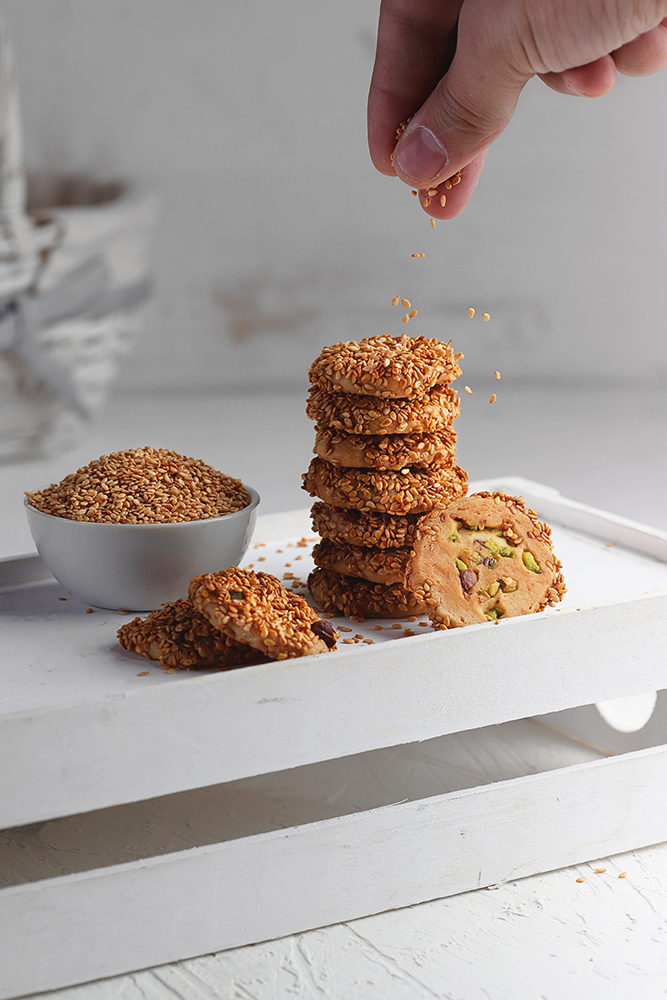
If you have seen my Theme Reveal for the A2Z Challenge 2022, then you will know that I am writing about becoming Vegetarian gradually as a response to the crisis in food supply chains sparked by the pandemic and made worse by the WAR in Ukraine. As well, I am keeping to the theme I originally planned of food which can be eaten in its own right as well as becoming an ingredient in other dishes…

Okay, so eating sesame on its own is a bit of a stretch but I had to shoehorn it into this A2Z because I love sesame and keep it in my kitchen in several forms. I honestly can’t remember whether the first time I encountered sesame was in the form of Sesame Snaps (bought ones but a recipe here) or Gomasio which is a delicious condiment made simply of salt and toasted sesame – it is so long ago and these things seem always to have been in my life…
Gomasio
1. take 2 cups of raw sesame seeds and toast them in a wok or frying pan carefully stirring till just turning brown
2. Add the toasted seeds and one tablespoon of sea salt to either a mortar and pestle or a grinder/blender and grind until it forms a coarse meal
3. Store in an airtight container and use in place of ordinary salt – it adds a nutty savour to your food. Some people like to add seaweed to Gomasio, kelp, dillisk (dulse), nori – all these can also be lightly toasted before combining with the salt and sesame and grinding for extra taste and minerals such as iodine.
Sesame seeds have little taste when raw but blossom with flavour once toasted so they are ideal to sprinkle on top of bread or cakes (see above) where they automatically get the toasting treatment. The other way of adding the nutty taste of sesame is to use Sesame Oil – this is something I gleaned early on from Chinese cookery – I will use a mixture of sunflower and sesame oil when making an omelette quick style (mess the eggs up with a fork and chuck it into hot oil in a frying pan as opposed to the separating the egg whites and beating to a froth kind). When you have a Chinese dish such as egg fried rice, this how they make the egg part and add it to the fried rice at the end.
Steamers
Nothing to do with supply chains – ships are diesel-powered, not steam these days lol, but more of supply chains later. No this is about cooking vegetables and other things – they are not exclusively a vegetarian implement – in fact I always use them for that logistic nightmare which is Christmas Dinner – carrots in the water at the bottom, sprouts in the next layer and frozen peas at the top. Cooking all these things together uses only one ring on your hob and uses less fuel so good for the planet.
Vegetables are not the only things you can use a steamer for – you may have had a Chinese or Japanese meal including steamed or even steamed and fried dumplings, meat or vegetarian, and thought that they involved some arcane Asiatic magic cookery techniques, but they are really easy to make. The first ones I tried used sausage meat as the basis with various additions, but since the object of these posts is to move towards vegetarianism (with the cost of meat going up) here is a recipe for steamed dumplings filled with stir-fried vegetables which is first steamed and then fried to give them a crispy bottom – it even tells you how to freeze them…
Supply Chain Issues…
Supply Chains mean the linking of one or more sequential factors in the supply of food. Initially sparked by Covid19 but exacerbated by the war in Ukraine, these problems look to get worse as 2022 progresses. They might include the following, failure at the farm side, failure in the picking, failure to deliver, and failure at the food processors. At the farm or faraway plantation, covid reduced the workforce available and likewise to harvest produce. Of course, in Britain, we are especially cursed by our insane decision to leave the EU and close the door to migrant workers who used to plant and pick vegetables. Likewise, abattoirs are short of skilled butchers. Brexit also compounded the shipping of produce with lorryloads of strawberries and fish rotting as they failed to get through to the ports in time, mired in red tape which the Tory government promised would not be a problem… Supermarkets and food processors all have staff shortages and if you have problems at all these possible stages, you got you a Supply Chain Issue. Some of these issues are relatively local, but the increase in oil prices means the shipping of say, apples from New Zealand to the UK, might be prohibitively expensive – it is a challenge to globalization.
Is there a silver lining? Well everybody from nations to individuals, could grow their own. British apples, because of their seasonality, have decreased in popularity as they have been supplanted by apples from every part of the apple-growing world until it’s too much trouble for supermarkets to host UK produce during it’s season. Well not anymore! Learn to embrace your local seasonal produce, grow your own in your garden or allotment – if life hands you lemons…